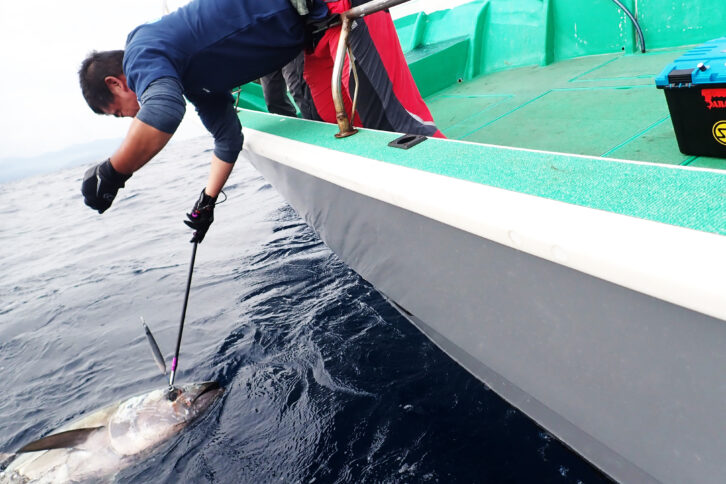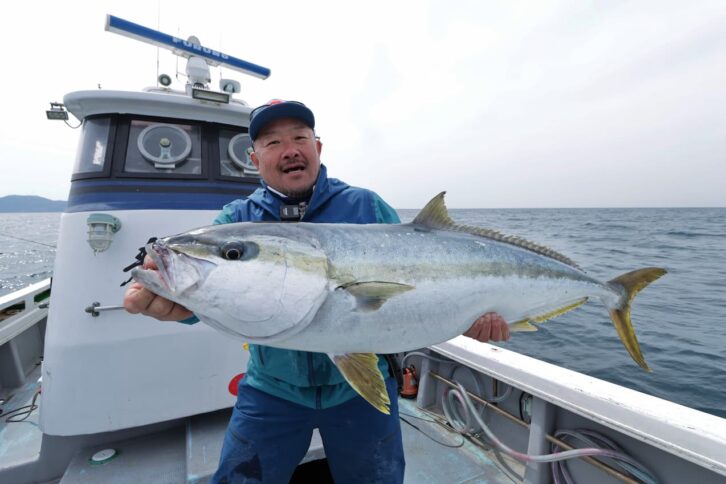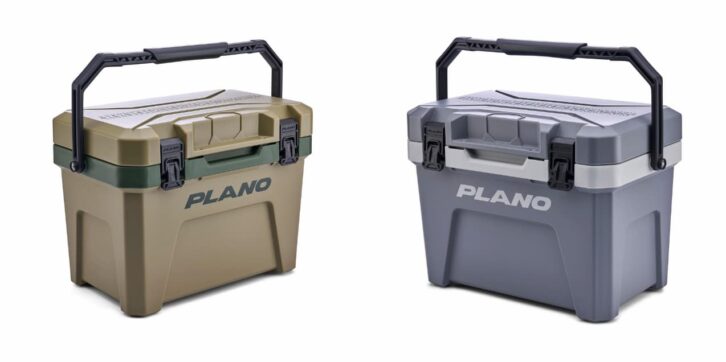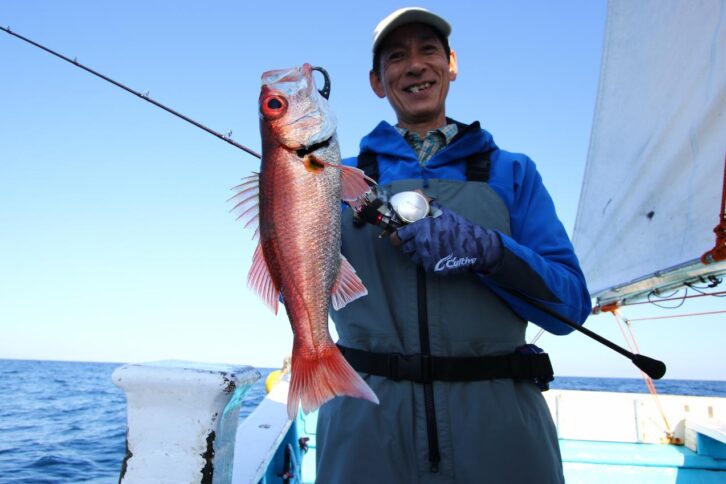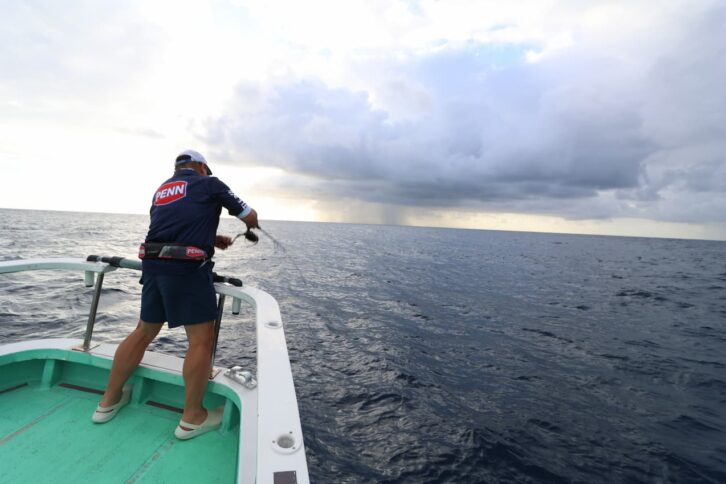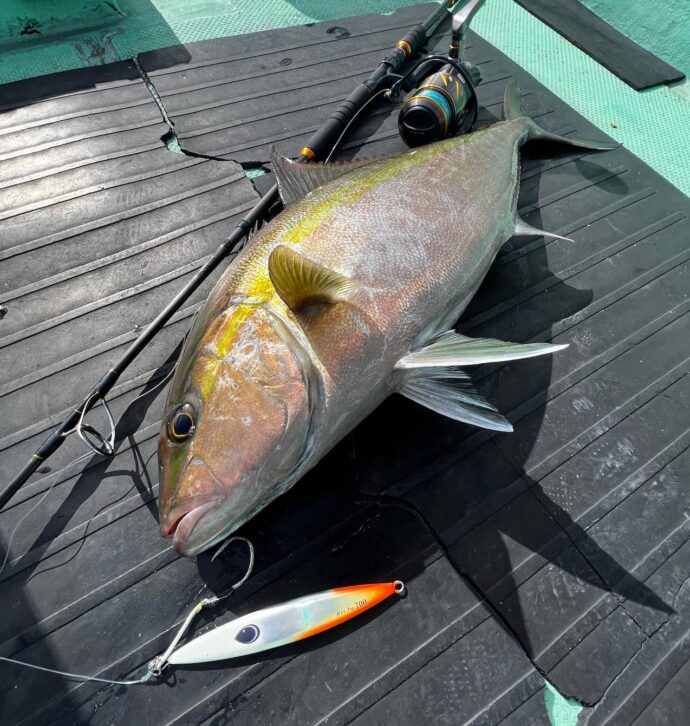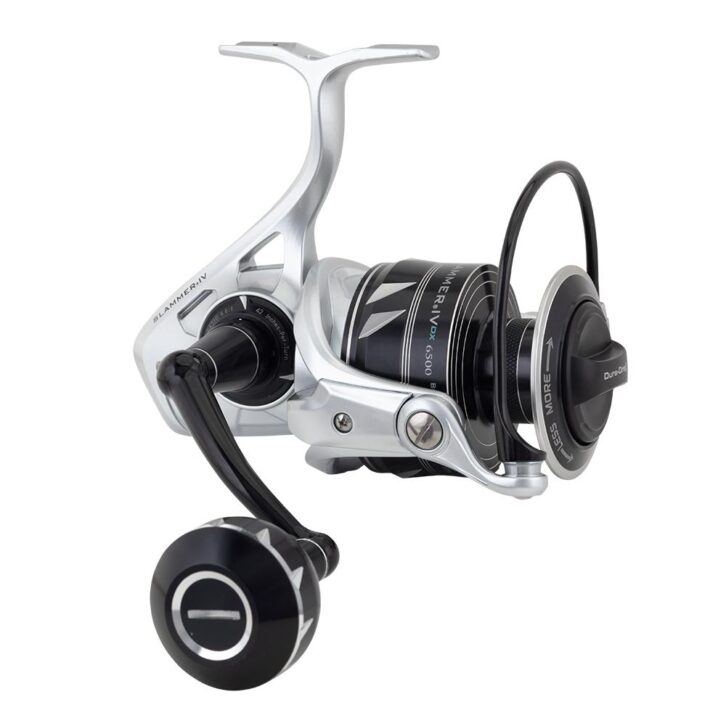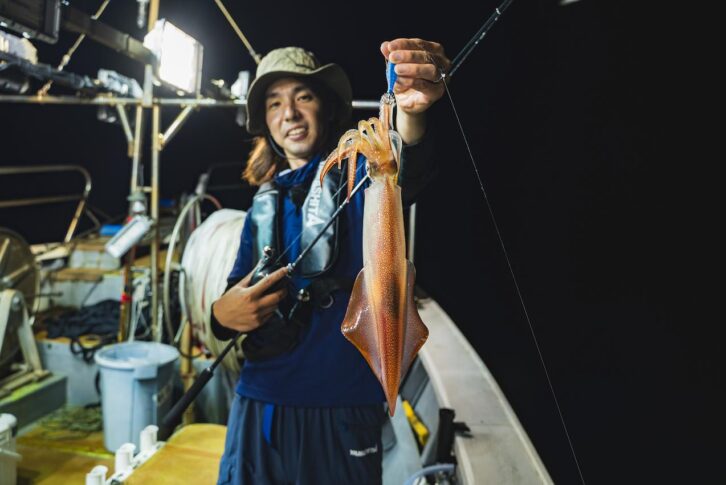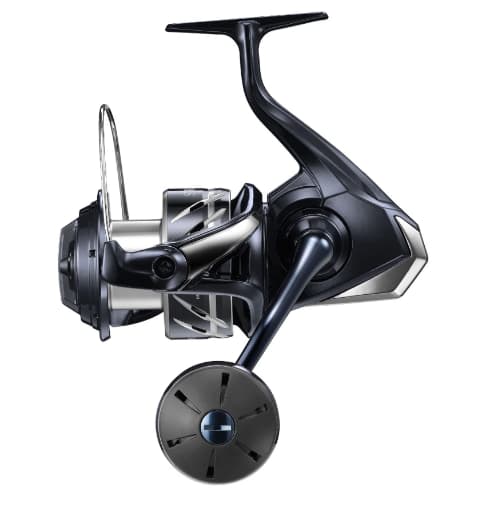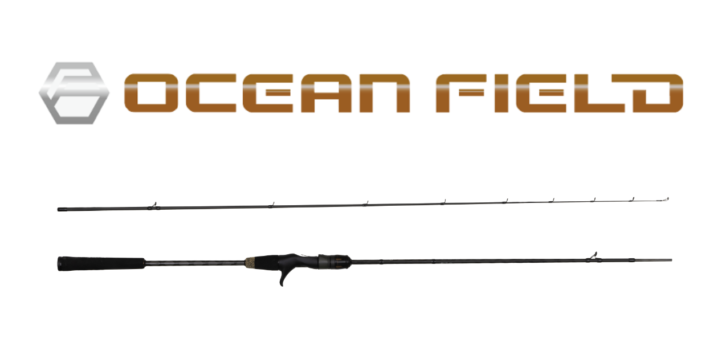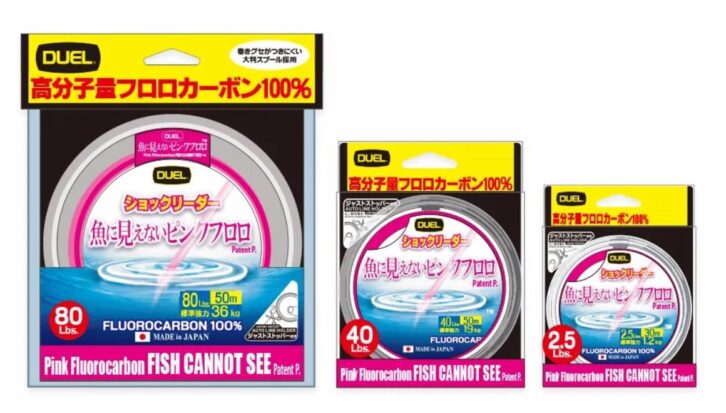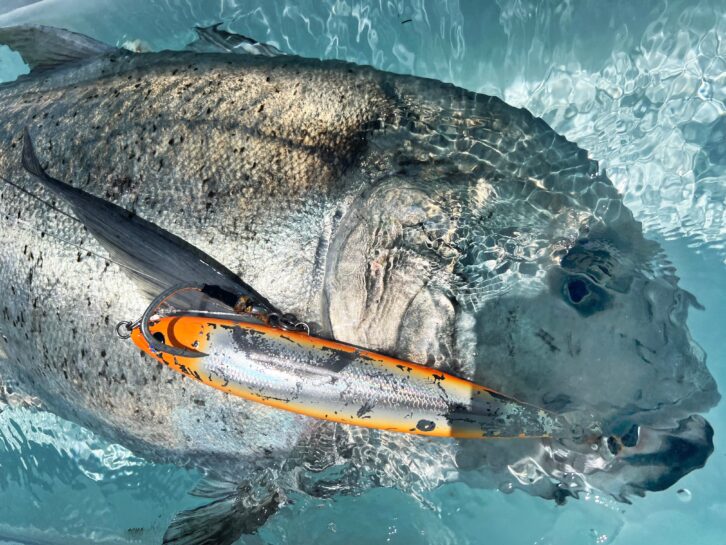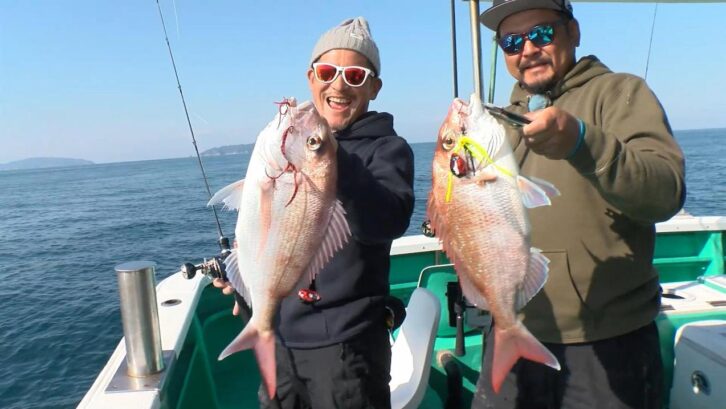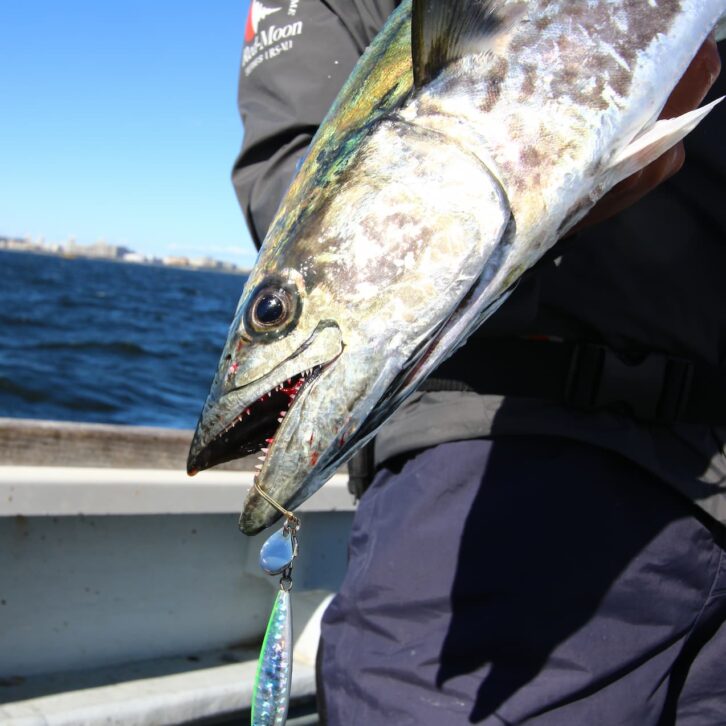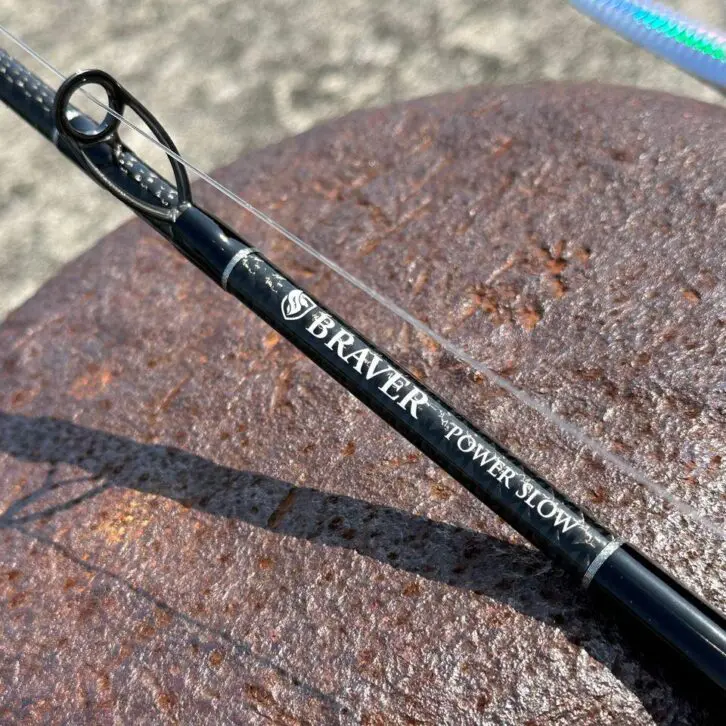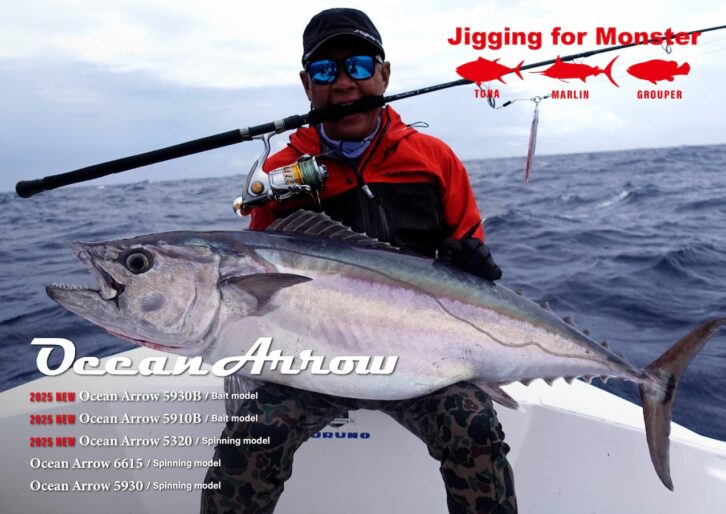【Expert's Secrets to Bluefin Tuna Fishing】
Challenging with a Dedicated Jigging Style
Yasuo Nishimoto’s Bluefin Tuna Strategy
Yasuo Nishimoto, an expert in slow-pitch jerk jigging. He established the fundamental style for tuna jigging using slow-pitch jerk techniques on Kume Island, Okinawa Prefecture. Leveraging this experience and methodology, he continues to challenge himself in bluefin tuna jigging. Based on his results to date, we introduce the current state of Nishimoto-style bluefin tuna jigging as of 2025.

INDEX
- Challenging Bluefin Tuna with Jigging
- The size Mr. Nishimoto anticipates by 2025
- Reel Selection for the Target Size
- Reel Settings for Fishing Trips
- Prioritize line strength; use longer leaders
- Use new line, never reuse old line
- Bluefin Tuna Line System and Hardware
- Rod Selection. Developing models for tuna.
- Jig Selection Prioritizes Appeal
- Select hooks that catch on the corners of the fish’s mouth.
- Luring Bluefin Tuna
- From the Hit to the Fight
- A word for anglers about to take on this challenge
2025 Bluefin Tuna Game
For recreational bluefin tuna fishing in 2025, monthly catch quotas are set by the Fisheries Agency: an annual total of 60 tons, with a monthly limit of 5 tons (reduced to 3 tons starting September). Quotas may fluctuate if the previous month’s catch exceeds the limit. The 2025 season begins April 1st. Anglers must report all catches, and fishing is prohibited for tuna under 30kg. For fish over 30kg, the limit is one fish per person per month, and must be reported within one day of landing.
The quota resets at the start of each month. Once the monthly quota is reached, bluefin tuna fishing is prohibited. Given this, the quota is often reached within the first few days of the month. To allow more anglers to participate, some charter boats encourage catch-and-release. Release should be done in consultation with the captain and fellow anglers on board, who are experienced with release procedures.
Also, fishing for tuna, which are much larger than humans, can involve accidents during the fight and landing, as well as damage to equipment due to unexpected use. We have heard of actual injuries and equipment problems. Please recognize that fishing is done at your own risk and enjoy it while ensuring sufficient safety. And when fishing for tuna, please challenge yourself with solid knowledge and the physical strength to deal with large fish.

Yasuo Nishimoto, an expert in slow pitch jigging. He perfected the Faure technique, now common in yellowfin tuna jigging, and currently applies it to bluefin tuna. And he is getting results. We interviewed him about his many techniques for catching bluefin tuna.
Challenging Bluefin Tuna with Jigging
Yasuo Nishimoto is widely known as an expert in slow pitch jigging. He has targeted a wide range of fish, from bluefish in coastal waters to deep-sea and mid-water species, as well as big game fish on expeditions. Among these, his slow pitch jigging technique for targeting yellowfin tuna at the Kume Island fish aggregating device (FAD) has become commonplace since he published it in magazines and other publications. Kume Island is a year-round field for yellowfin tuna, but the spread of tactics based mainly on appealing to the fish with slow pitch jerking and the Faure has made it possible to catch good-sized fish more consistently. After establishing his slow pitch jerking tactics for yellowfin tuna, Mr. Nishimoto began challenging himself to catch even larger tuna, bluefin tuna.
“The trigger was information from Mr. Hiranaka of Sapporo North Cast, who said, ‘It seems you can fish for bluefin tuna in Hakodate!
In 2018, Mr. Otsuka, the chairman of Studio Ocean Mark (hereinafter SOM), with whom Mr. Nishimoto has a contract as a tester, went to investigate. The result was a reply saying, “You can fish there!” Although the fish Mr. Otsuka caught at that time weighed about 30kg, it was a major step forward, confirming that the techniques honed in Kume Island were effective. Mr. Nishimoto also immediately went to Hokkaido and achieved results.
At the time, there was a prevailing belief that “You absolutely must use casting to target bluefin tuna!” However, it’s common for bluefin tuna to show signs of activity underwater without surfacing, jumping, or forming feeding frenzies. If casting proves ineffective, jigging becomes a viable alternative. As a jigging expert, Nishimoto pursued this potential, leading him to test bluefin tuna jigging annually in Hokkaido and other fields.
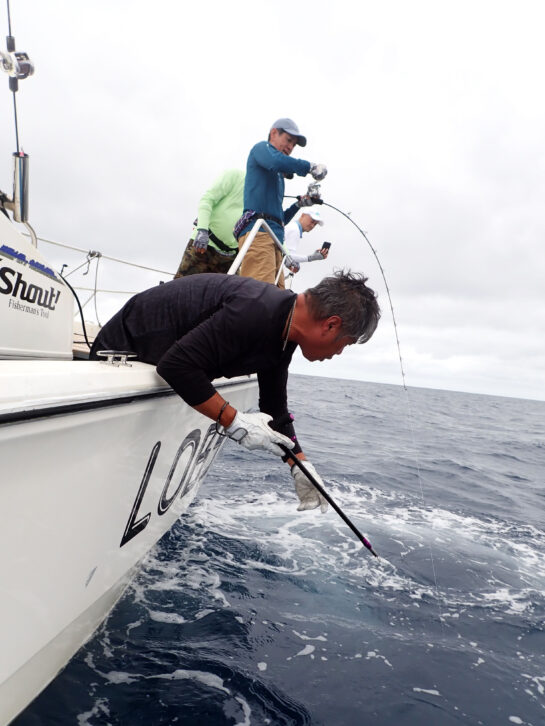
While casting is widely regarded as the method for targeting bluefin tuna, mastering jigging techniques allows anglers to succeed even when tuna refuse to surface. And jigging has its own unique appeal.
The size Mr. Nishimoto anticipates by 2025
During his first challenge in Hakodate, Hokkaido, where fish around 30kg and 40kg were being caught, he tackled them with PE #3 line. The following year, the tuna size increased to 50kg, and the year after that, to 60-70kg. Simultaneously, the line size used also grew thicker. Nowadays, with increased chances of encountering tuna over 100kg, he often selects PE8 line. As tuna stocks recover, sizes and catches increase year by year. The reality is you can’t choose the size.
“Currently, considering the tackle I use and the tackle under development, my projected average size is 100kg, and pushing hard, maybe 150kg. However, in the current field conditions, 100kg fish are migrating, and 200kg-class fish are also migrating. You never know what size will bite, but I set 150kg class as one benchmark. For me, while honing my fishing skills, one key factor in developing gear is whether the resource is abundant and whether it’s a fish whose population can be sustained through stocking or similar measures. Bluefin tuna, thanks to regulations, have seen their stocks recover, so I feel confident targeting them. Their size is also increasing year by year, making them an interesting target, including for tackle development.”
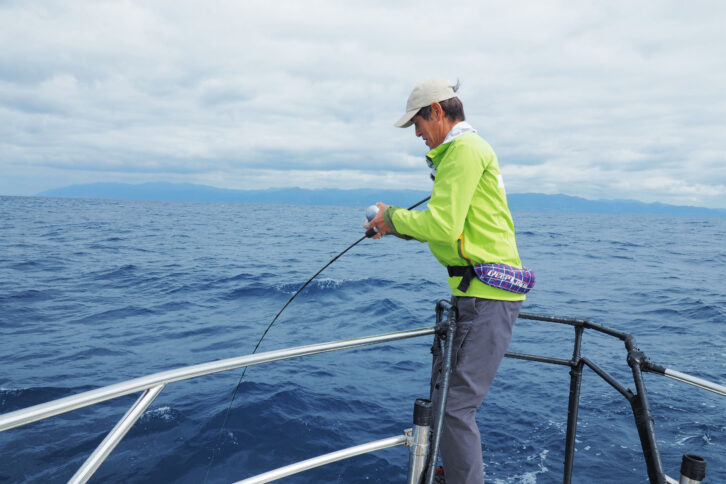
Mr. Nishimoto’s target size, given his current tackle setup, is a maximum of 150kg. He’s tackling them with PE8 line.
Reel Selection for the Target Size
What kind of tackle should you select? First, choosing the right reel is important for facing large bluefin tuna. Mr. Nishimoto uses a bait reel because he searches using slow pitch jigging, and the reel’s performance greatly affects the catch. First, bait reels feed and retrieve line in a straight line, which reduces line degradation and also provides strong winding torque. When fishing for large fish, they place less strain on the line and the angler than spinning reels. The criteria for choosing such a bait reel are, first, a size that can hold at least 300 meters of line. Furthermore, it needs a body strong enough to withstand the powerful pull of large fish, a strong drag, performance that can handle line release during high drag, and winding power (torque). It also needs to have a lever-type drag. Lever drag reels allow you to precisely control the drag value by raising and lowering the lever. In tuna fishing, you gradually increase the drag according to the fish’s movements from the moment it hits, applying pressure to stop it from running, and then start reeling it in. Proper drag adjustment makes it easier to control the fish’s movements and reduces the likelihood of problems. As a result, Mr. Nishimoto has selected the Studio Ocean Mark (SOM) Blue Heaven L100.
“The Blue Heaven L100 comes in different gear ratios and models, and I use different ones depending on the gear ratio when targeting bluefin tuna. The models I use are the NO LIMITS Blue Heaven L100Lo (77cm per handle rotation), Blue Heaven 100Pw (95cm per handle rotation), and 100Mid (100cm per handle rotation).”
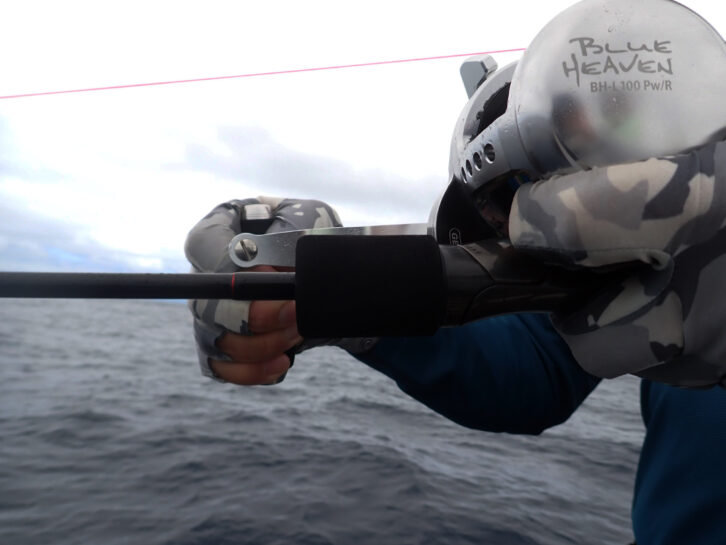
The reel is the SOM Blue Heaven L100 size. While Blue Heaven is known for its winding torque, we use the NO LIMITS L100Lo, L100Pw, and L100Mid from the lineup, which offer the strongest winding power.
Although Blue Heaven also offers Hi high-gear models, they are not considered for bluefin tuna retrieval because it requires torque. Incidentally, the NO LIMITS Blue Heaven L100Lo was developed specifically for catching bluefin tuna and boasts a proven track record. It features a robust body that resists flex even under high drag settings, large gears, and powerful retrieve torque that allows you to steadily reel in the fish after the strike. It also handles heavy jigs with ease, conserving your strength until the strike. The gear ratio is 4.0:1. While the maximum retrieve is 77cm, it was engineered to reliably retrieve line even during high-drag fights exceeding 10kg. Maximum drag capacity is 14kg. Furthermore, its design incorporates heat dissipation holes throughout the gear housing and body, and the spool’s waterproof cap was changed to aluminum. This successfully reduces the maximum operating temperature during high-speed spool rotation by over 10 degrees. It handles the powerful runs of bluefin tuna under heavy drag.
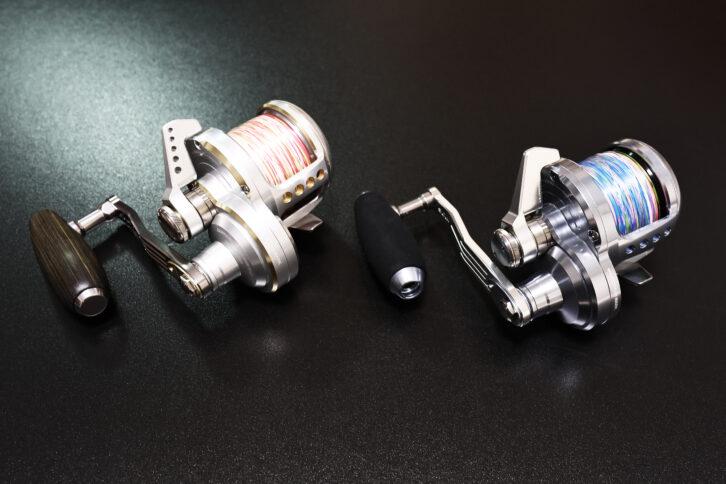
NO LIMITS Blue Heaven L100Lo (left) and standard Blue Heaven L100 (right). Built for big fish with a rugged body, large gear, and high drag capacity.
【NO LIMITS Blue Heaven L100Lo】
https://studio-oceanmark.com/products/no-limits-blue-heaven/

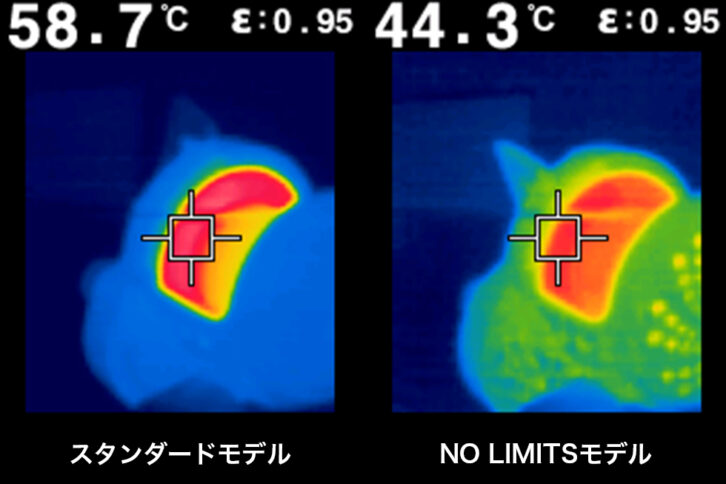
The NO LIMITS Blue Heaven L100Lo features a gear ratio enabling retrieval even with high drag settings exceeding 10kg, plus a heat-dissipating waterproof cover and waterproof spool cap. Designed to suppress temperature rise during high-speed spool rotation.
“At first, I thought the NO LIMITS Blue Heaven L100Lo’s low gear ratio meant the distance retrieved per handle rotation was too short, but when targeting bluefin tuna, you often get bites on the Faure after the retrieve rather than on a fast retrieve, so it’s not a problem. Furthermore, since we often fish in relatively shallow areas, around 120m deep, the low gear ratio is sufficient.”
When fighting bluefin tuna, you increase the drag value to stop their strong runs, and when they stop running, you reel in the line as quickly as possible to close the distance. However, there are times when the fish is resisting without running. At such times, it is important to reel in as much as possible. If you can reel in even a quarter turn or half a turn of the handle, you do so, gradually closing the distance. For these moments, Nishimoto relies on the NO LIMITS Blue Heaven L100Lo, developed specifically for bluefin tuna with its high winding torque. Its ability to reel in powerfully gives an over whelming advantage.
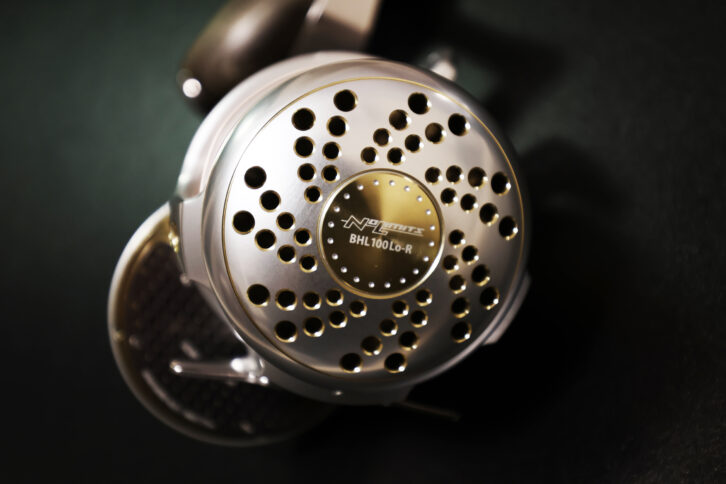
The NO LIMITS Blue Heaven L100Lo, engineered for catching bluefin tuna. Anyone who uses it will feel its exceptional winding power upon hooking a fish.
Incidentally, the NO LIMITS L100Lo and standard models like the L100Mid and L100Pw feature a reverse prevention mechanism for high loads, as they are intended for use against large fish.
“The NO LIMITS L100Lo, standard L100Mid, and L100Pw, designed for use with thick line and high drag, come equipped with a stopper, providing greater peace of mind even under heavy loads. For these reasons, these three models are recommended for bluefin tuna fishing.”
Additionally, the Blue Heaven L120Pw, which has greater line capacity than the 100 models, is also suitable for bluefin tuna jigging. Furthermore, the OGM Blue Heaven L100Pw (95cm per handle rotation), released in Fall 2025, will likely join the lineup of reels capable of handling bluefin tuna.
【Blue Heaven L100Mid, L100Pw】
https://studio-oceanmark.com/products/blue-heaven-100-80-50-30/
【OGM Blue Heaven L100Lo】
https://studio-oceanmark.com/products/ogm-blue-heaven-100/
Reel Settings for Fishing Trips
By the way, how do you set the drag? What’s the initial setting in kg?
“I set it to 8kg or 9kg at the strike position, which is the lever position during jerking. From there, it increases by 1kg with one click. It goes up to 3kg at the fight position, and then another 2kg at the MAX position. The drag is set to go up to 14kg.”
Control the appropriate drag value with the lever.
“The standard L100Mid and Pw use a cork drag. When applying heavy load during prolonged fights, the drag can overheat during the fight, causing the cork to shrink and inevitably leading to drag slippage. In such cases, I sometimes time it when the tuna isn’t moving, quickly return the lever, and tighten the drag dial about 90 degrees.”
Incidentally, the standard L100Mid and Pw models come with a cork drag spool upon purchase. The NO LIMITS L100Lo includes a carbon drag spool. So which is better suited for tuna?
“Cork drag can deliver strong drag force if the cork is sufficiently strong. However, maintaining high drag for prolonged fights can cause the drag setting to shift. Additionally, under high loads, issues like cork wear can occur. On the other hand, the NO LIMITS L100Lo carbon drag is designed to withstand high loads and high-speed rotation. Carbon pairs well with stainless steel, so we use carbon for the drag washers and stainless steel for the drag disc. If you purchase a standard Blue Heaven, it’s also possible to swap just the spool for one with the carbon drag. Personally, I use a carbon spool for tuna jigging.”
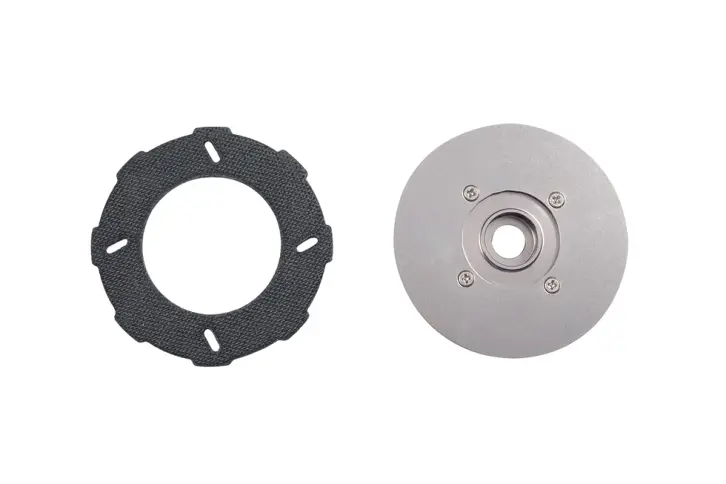
Blue Heaven offers models with both cork and carbon drag washers, but carbon is recommended for bluefin tuna fishing. It withstands high loads and high-speed spool rotation.
Prioritize line strength; use longer leaders
As mentioned earlier, Nishimoto currently selects 8-pound test line as his standard. His line of choice is exclusively XBRAID’s ODDPORT WX P-18. The reason is ODDPORT ‘s construction: it features a core within an 8-strand braid. Its linear strength is the highest among XBRAID’s PE lines. The core prevents flattening, reducing line degradation. Its moderate stiffness also ensures excellent release properties. It is truly the ideal PE line for large fish.

【XBRAID ODDPORT WX P-18】
https://xbraidygk.jp/products/oddport/
“The reason for choosing it is simply because it’s strong. As a line selection criterion, an 8-braid line with some stretch makes it easier for anglers to fight fish, but ODDPORT is chosen for its high strength despite its low stretch. When entering fields with fast currents, such as the Tsugaru Strait, PE8 can sometimes cause poor jig entry (Faure), so I sometimes drop down to PE7. When I was expecting 50kg, 60kg, or 70kg fish, I used PE6, but now I mainly use PE8, and PE7 depending on the situation.”
The Blue Heaven L100 size he uses has a line capacity of 350m with ODDPORT PE8 and 400m with PE7. He also selects a 40 leader for the end of the PE line.
“I use a 10m section of 40lb fluorocarbon leader. I keep it longer because I want to utilize the leader’s stretch during the fight. While the stretch also makes the fight easier on my body, the main reason is that using low-stretch PE/ ODDPORT with a short leader puts stress on the knot connecting the PE line and leader, as well as the knot at the jig attachment ring. A longer leader absorbs that stress. Incidentally, comparing the stretch of nylon and fluorocarbon: nylon stretches from the start, while fluorocarbon resists stretching initially but breaks with about 20% stretch, similar to nylon. However, I choose fluorocarbon because its knots hold stronger than those of water-absorbent nylon. Also, although tuna fishing does not involve rubbing against rocks, there is a possibility that the leader could be damaged by the fish itself. In that case, nylon will break and tear from the damage, whereas fluorocarbon has greater durability than nylon because its fibers are arranged vertically. Another reason is that fluorocarbon has a higher specific gravity, making it easier to synchronize with the jig’s Faure.
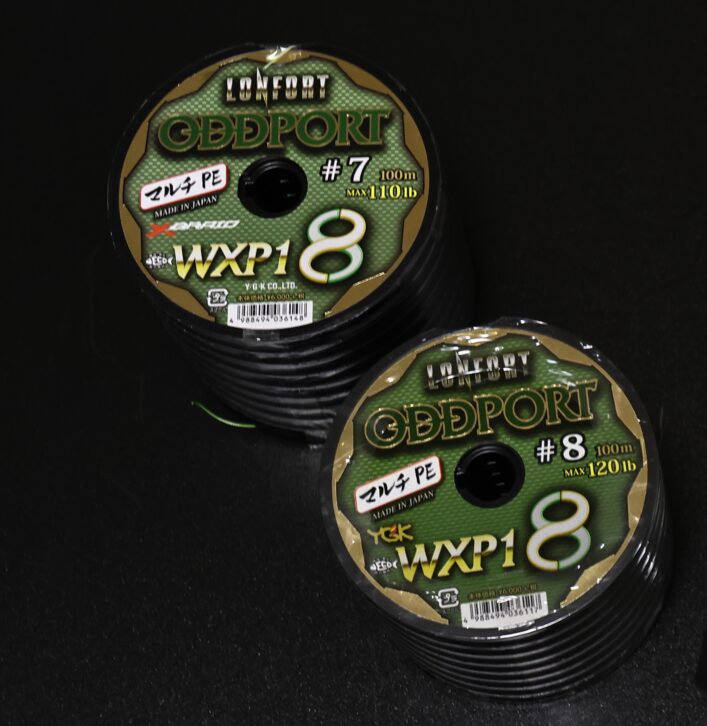
The line selected is XBRAID’s ODDPORT WX P-18. The reason for this selection is that it is stronger than a normal 8-strand braid. With a structure of 8 strands + 1 core, it is strong, resistant to crushing, and has little strength degradation. ODDPORT has low stretch, so a 10m leader is connected to create a stretch section, reducing fatigue at the knot.
Use new line, never reuse old line
When preparing to spool line for bluefin tuna fishing, Mr. Nishimoto uses the UOYA Thread Winder Factory IK500. For PE8 line, he sets the drag checker (Sakurai Fishing Tackle) to a load of 3.5kg to 4kg and begins winding, adjusting the load slightly downward as he goes. For the final 100m, he winds with almost no load, using light tension. Winding with light tension at the end is crucial because this section corresponds to the line released when jigging. Winding this section under high load risks the line spilling off the spool during retrieval, since the load isn’t maintained at that point. Winding with excessive force to maximize capacity not only reduces line strength but also invites retrieval problems. Incidentally, Mr.Nishimoto advises not winding the line to the spool’s maximum capacity, but slightly less. This ensures space for the leader when it’s added and prevents the line from spilling over the spool edge during retrieval if it winds unevenly.
“Also, if you’ve ever fought a bluefin tuna over 80kg, you should assume the line is damaged and replace the spool. You can tell the line is damaged when fighting a fish with strong drag. This damage comes not just from retrieving and releasing line, but also from the substantial stress the fish’s movements exert on the line in viscous water. Furthermore, reels subjected to high loads during prolonged fights may develop issues, so I recommend sending them for overhaul after returning from a trip. Keeping the reels and line used for big game fishing in peak condition is crucial.”
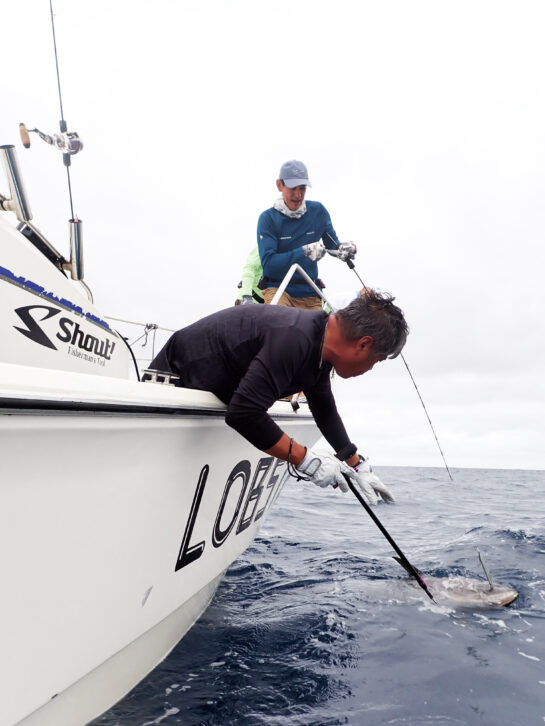
Bluefin tuna fishing involves heavy loads during the fight, so line degradation is inevitable. To land that dream size or personal record, always start with fresh line.
Bluefin Tuna Line System and Hardware
Mr. Nishimoto uses the PR knot for joining his PE line and leader. He also applies stronger tension than usual when winding thicker lines like PE #8 for targeting large fish.
“I use a heavy bobbin winder to apply strong tension when winding the PE onto the leader. I use the MC Works PR Bobbin HEAVY (100g) model.”
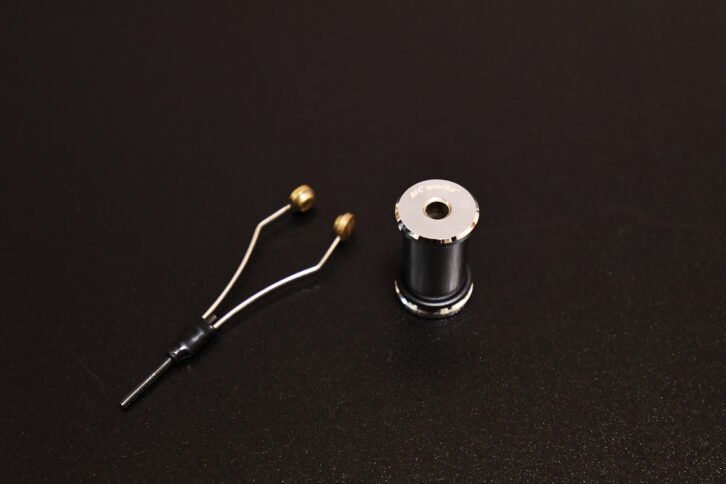
He keeps the wrapped length longer, around 10cm.
“The extra length is my weak heart talking (laughs).”
Since it doesn’t interfere with the guides like during casting, the length isn’t an issue. After wrapping, he does the half-hitch braid: 10 wraps over the leader section, then 10 wraps solely on the PE line. He then backtracks 3 wraps and braids them together. Backtracking makes it less likely to come undone. For the leader tip hardware, I use thicker-gauge welded rings. For the split ring, I use the SOM Track Split Ring #6. It’s a model rated for 440lb strength.
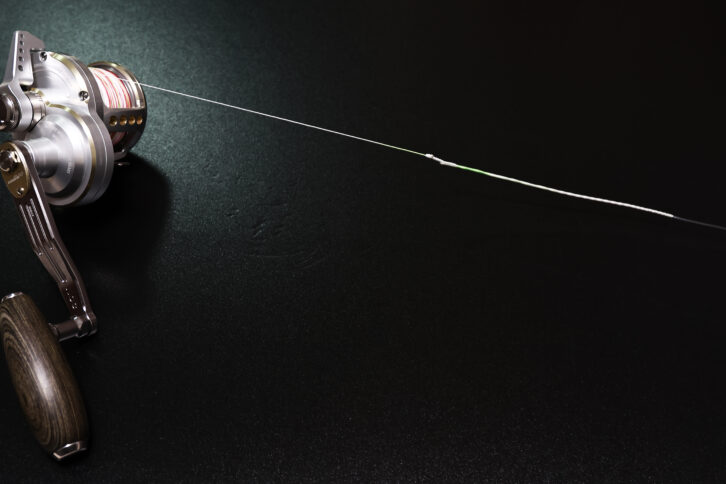
For the leader-PE connection, I use the PR knot I normally do, but considering potential slippage during strong pulls in the fight, I use a heavy-duty knotter to wrap it securely. I also wrap it longer.
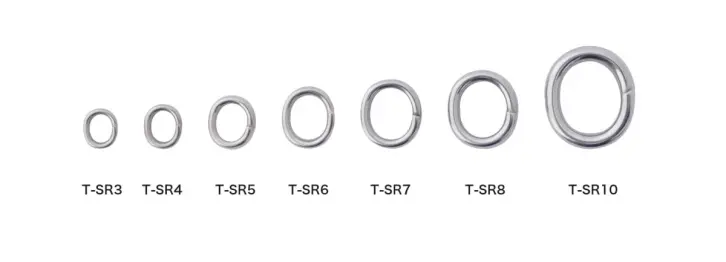
Reliable hardware is essential. SOM’s OTA Garage Track Split Ring is the strongest ring available. Mr. Nishimoto states he has never experienced any issues with it.
【SOM・OTA Garage Track Split Ring】
https://studio-oceanmark.com/products/track-split-ring/
The leader is tied to the ring using a Palomar knot.
“This knot provides consistent strength regardless of who ties it and won’t slip out. Typically, you just tighten the knot, but I then use the leader’s excess line to weave in half hitches. I alternate this process 5 to 10 times. Thick fluorocarbon leaders are hard to tighten, so I apply SOM’s KS Liquid before tightening. Applying the liquid allows for a tight, secure knot.”
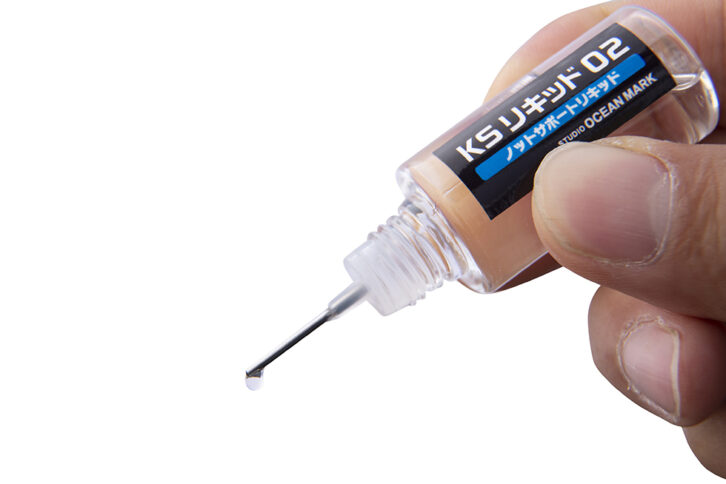
Thick fluorocarbon leaders require significant force to tie securely, sometimes preventing a full tightening. However, using KS Liquid makes tightening possible. It’s also good because it doesn’t leave your hands sticky like Vaseline does.
【KS Liquid】
https://studio-oceanmark.com/products/ks02/
Rod Selection. Developing models for tuna.
Mr. Nishimoto develops and uses rods from Deep Liner and Garage NAGI. Among these, which model does he recommend for targeting bluefin tuna?
First, even for bluefin tuna, he chooses carbon tubular models with strong lift-off power. While recent slow rods include carbon solid models that bend during the fight, Mr. Nishimoto prefers tubular products for their maneuverability. Currently, in 2025, his go-to bluefin tuna rod is the 6-foot-3-inch TUNA model from Garage NAGI’s Cross Border series, which is still in testing. Garage NAGI rods are designed for expedition and overseas use, featuring high resistance to breakage and damage. This test model also prioritizes strength.
【Garage NAGI Homepage】
The TUNA model currently in testing is designed at 6 feet 3 inches. This length makes it easier to avoid the hull at the bow when the tuna turns during the final moments of the fight. It’s a model developed with the premise of fighting the fish by pinning it against the side. While there are flexible, slow-pitch rods that can be held upright, such rods inevitably compromise the ability to “maneuver the jig.” Personally, I didn’t want to lose the joy of hooking fish, so I developed this model with high maneuverability.”
Incidentally, this series comes in L, M, and H models. The L is designed with yellowfin tuna in mind, the M targets large yellowfin and small bluefin tuna, and the H is designed for large bluefin tuna.
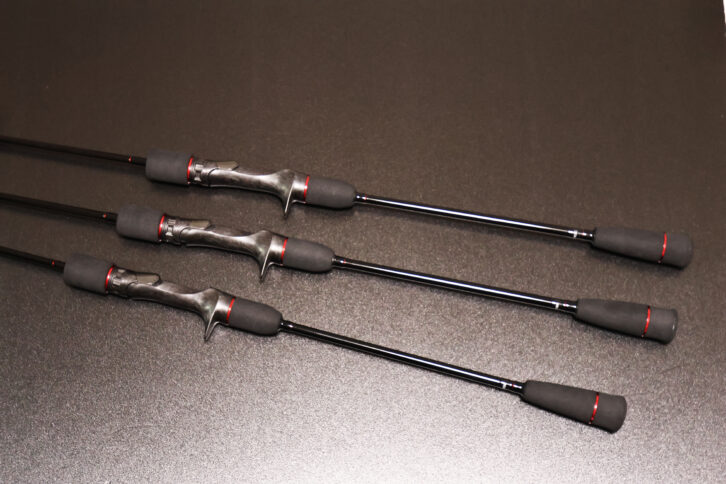
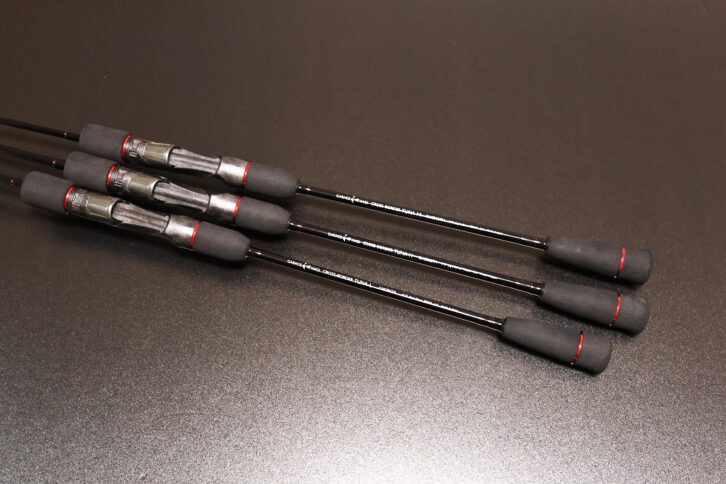
The Garage Nagi Cross Border TUNA series, currently in development for release next spring. Models crafted specifically for tuna fishing. They boast exceptional maneuverability.
“We’re testing rods held under the arm, but that doesn’t mean we always fight straight. While holding it under the arm, we apply pressure by bending the rod to apply as much pressure as possible during the fight. Then, while utilizing the reel’s power, we recover the slight slack when the bend returns, incorporate pumping motions by moving the rod up and down to retrieve line, and gradually reel in the line to close the distance.”
Even with a hookset-focused rod, the rod bends during jig operation, using the rebound to jerk the jig upward. It’s not that it doesn’t bend. If you know how far you can bend it before it breaks, you can apply pressure by bending it while holding it under your arm.
Also, this rod features a new model reel seat. This was custom-made after consulting with Fuji Industries.
“I wanted a carbon reel seat, and since there wasn’t a thick reel seat in their recent lineup that would fit the Blue Heaven, I had them make one. The size 16 reel seat we use was an existing product, but we had them create a new size 19. This reel seat is exceptionally rigid and solidly built. It doesn’t loosen during high-load fights or long fights. There are no seams, so your hands don’t get sore during the fight either.”
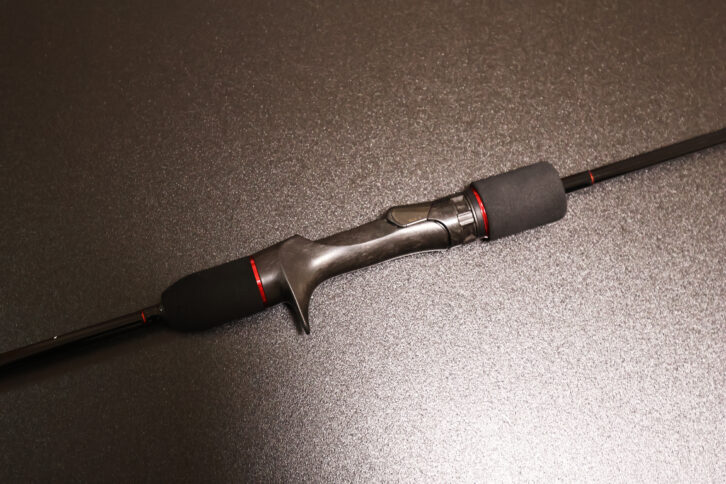
The sleekly shaped reel seat. It’s a model specially made by Fuji Industrial to match the large Blue Heaven. The grip feel is outstanding.
The guides use titanium SIC, and the butt section is positioned higher. This is because the reel is large. When a large reel is attached, this prevents the line from interfering with the guides. Also, this series is a one-piece design. At 6 feet 3 inches, it fits easily on domestic flights, and a one-piece construction offers better sensitivity and handling. Another reason for the one-piece construction is that with a two-piece design targeting large fish, the high loads during the fight could cause the blank to rotate, potentially knocking the guides out of alignment. Incidentally, this rod is currently in development for release next spring. We look forward to seeing it in action during the 2026 season.
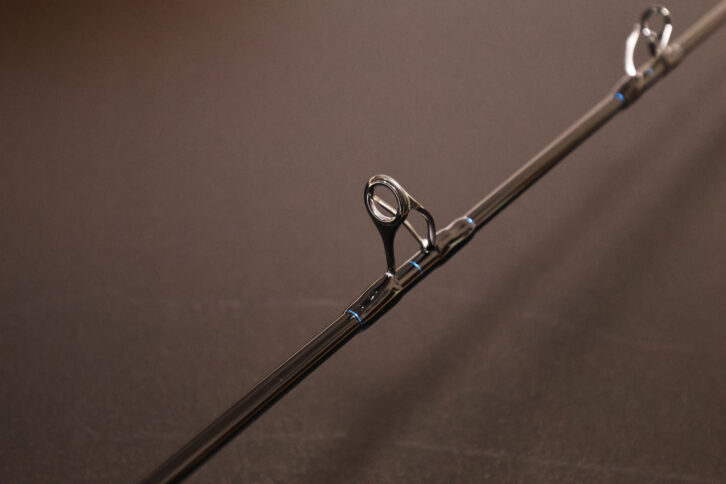
The butt guide is set higher to accommodate large reels.
Incidentally, for existing products currently on sale, the Garage Nagi Cross Border GNCB60#6 and GNCB60#8 are recommended.
“The #6 model is an extremely easy-to-set-the-hook rod. The #8 has power, provides a sense of security, and has good handling, but the tip recovery is slightly faster, so I feel it’s harder to execute the hook-setting motion compared to the #6. For targeting larger fish, the #10 is also an option. Its tip recoil during jerks is even quicker, making it easier to use when incorporating high-pitch jerks to entice fish. However, the larger the rod number, the greater the sense of security after hooking and the pressure felt when bending the rod. The rod number selection depends on whether you prioritize the action before hooking or after hooking. Personally, I prefer enjoying the action before hooking more, so I often use the #6. Incidentally, the 6’3” model currently in development prioritizes handling and feel during the hookup process, so I believe it will enhance the enjoyment of tuna jigging.
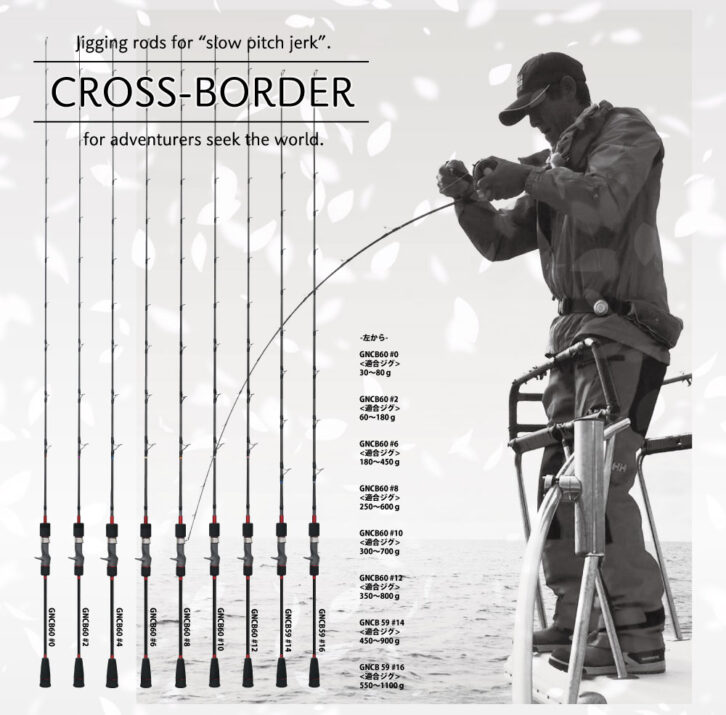
【CrossBorder】
https://garagenagi.com/crossborder.htm
【CrossBorder Fight Video】
https://youtu.be/8wJbv_PX694?si=4H1cuwLpefpsToqh
Jig Selection Prioritizes Appeal
What size and model of jig do you use?
“Since we often fish around 80m deep, I use around 400g jigs with PE8 line. If the boat uses a spanker to keep it upright, I use jigs lighter than 400g, and if the wind is strong and we’re drifting, I need 500g or 600g jigs.”
The basic approach is to drop the jig to the bottom of the target depth as instructed by the captain, and then search for fish with slow-pitch jerks and a solid Faure. But is there a best jig for this?
“It’s best to use a jig with a large surface area and a long, noticeable shape. It doesn’t need to be compact; the important thing is to get the attention of the migrating tuna. The flashing and silhouette of the jig attract the fish. I often use the DEEPLINER SPY 400g and 500g. Models that fall smoothly are best. I only attach a hook to the tail, but DEEPLINER jigs are weighted on the head side to give them action. If the head drops too low, the fall speed slows down and I often find that the bite is poor. To balance this and prevent the head from dropping too low, I attach a worn hook bent at the front so that it doesn’t hook. Also, when I feel that the bite is poor, I sometimes use Slow Skip CX or Slow Skip Fleck. When the water is shallow, I sometimes select the 300g Garage Nagi Drepper. Since the target layer can sometimes be shallow, it’s a good idea to have jigs ranging from 200g to 600g ready.
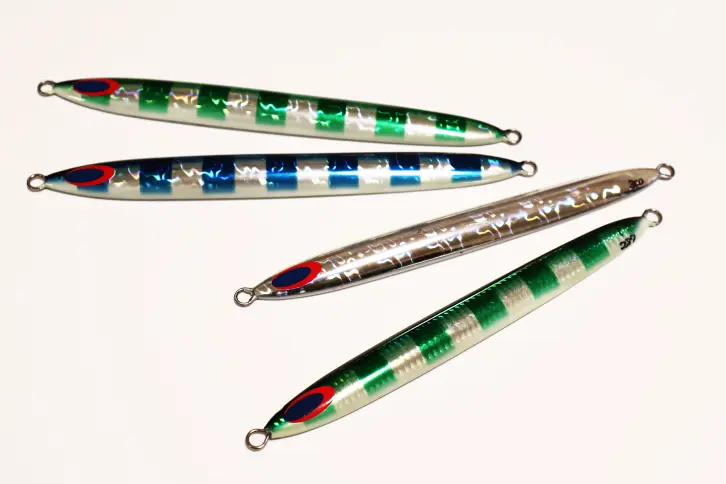
Mr. Nishimoto mainly uses the DEEPLINER SPY. He often uses the 300g, 400g, and 500g models. It appeals with a diagonal fall and vibration rather than a vertical drop. It also responds well to fast reeling.
【DEEPLINER・SPY】
https://www.deepliner.com/jig/spy.html
【DEEPLINER・Slow Skip CX】
https://www.deepliner.com/jig/slowskip_cx.html
【DEEPLINER・スロースキップ フレック】
https://www.deepliner.com/jig/slowskip_freq.html
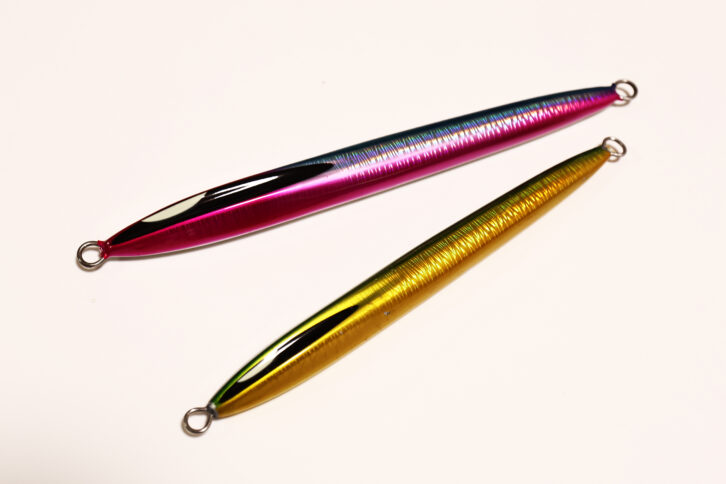
The Drepper from Garage NAGI, often selected for shallow water fishing. This model allows you to control short slide Faure and long slide Faure.
【Garage NAGI・DREPPER】
https://garagenagi.com/drepper.htm
Select hooks that catch on the corners of the fish’s mouth.
Based on past experience, as mentioned earlier, I attach one assist hook to the tail side of the jig. The reason for only the tail is that fish often bite during the fall, and if the front hook, which is playing around when the fish hits, hooks onto an unnecessary spot, it makes the fight difficult. Ideally, one hook should hook onto the barb. If the hook catches in the right place, the fight becomes much easier. Choosing a hook that catches too quickly can result in it catching in a place that is disadvantageous to the angler, making the fight difficult, so choosing the right hook is also important.
For fish up to about 50kg, I use SOM’s single assist hook, Seigi 25, but when targeting large fish, I use SUTEKI’s High Quality Hooks, SPGT. However, since the point of this hook is rounded, I use pliers to open it slightly to make an assist hook. Opening it makes the hook set smoother and releases easier, in my experience. I also find VANFOOK’s Beast Edge Cut Barb to be good. For the assist line, I use XBRAID Zylon Knot #70. After attaching the ring, I thread the entire length through the Zylon to create a double-layered structure. I tie this to the hook with a single wrap, secure the barb with thread, and reinforce it with instant adhesive. I bring several lengths to the fishing spot, but around 5cm is the most practical. Since I don’t keep the fish, I use barbless hooks.
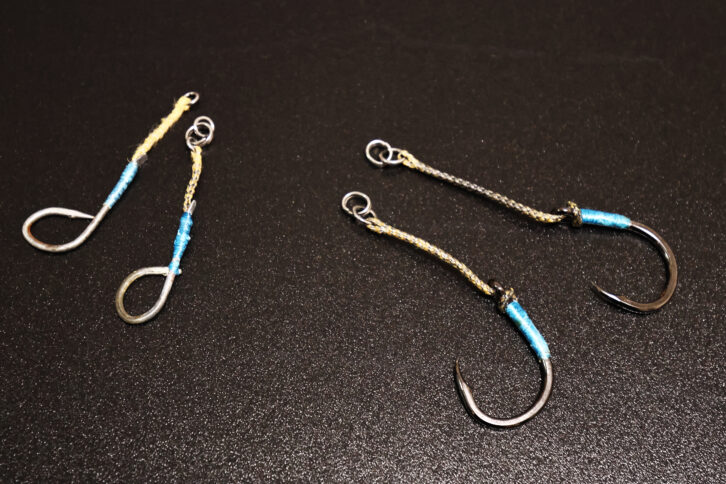
A single assist hook is attached to the jig’s tail. The jig used is designed with hooks on both the upper and lower sections to create movement. Therefore, a non-hooking hook is attached to the front eye to maintain balance.
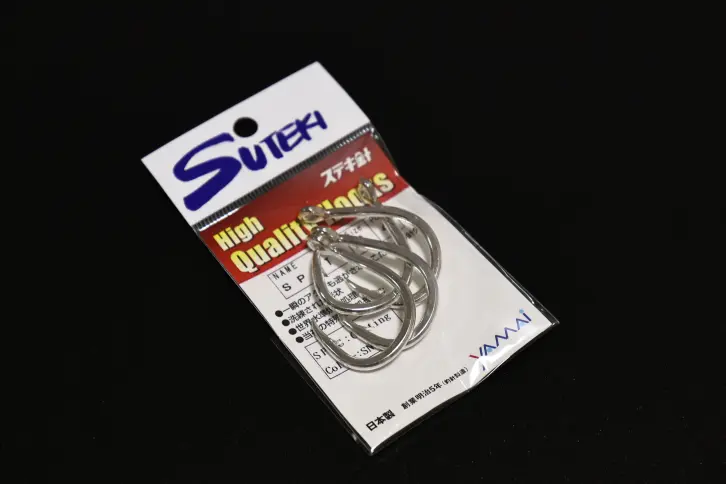
Currently using the beloved High Quality Hooks SPGT from SUTEKI-HARI. The thick wire diameter handles large tuna. I make the assist hooks using XBRAID’s Zylon Knot size 70.
【SOM・Seigi 25】
https://studio-oceanmark.com/products/seigi/
【XBRAID・Zylon Knot】
https://xbraidygk.jp/products/zylonknot/
Luring Bluefin Tuna
Currently, many bluefin tuna charter boats guide anglers using casting techniques. This is likely because anglers aboard want to “catch them by casting,” and captains also want to “let them catch them by casting.” Furthermore, it’s simply easier to locate tuna by spotting their jumps or feeding frenzies. However, captains with extensive experience fishing for bluefin tuna understand the timing of their migration and are familiar with the shoals where tuna gather. If you suggest searching for them using jigging, they will likely use fish finders and sonar to locate them.
As for how to search for them, Mr. Nishimoto says, “The fishing method is the same as the Faure-based approach cultivated through yellowfin tuna jigging in Kume Island.”
To explain this technique simply, you send the jig to the depth indicated by the captain, use a rod developed for slow-pitch jigging, bend the rod tip with the recoil from turning the reel handle, use the rebound force of the tip to bounce the jig up, and then add a fall action. You repeat this series of movements, searching the depth layer by layer. The movement of the jig’s fall is important, and you search for patterns while trying out different lengths and movements of the jig’s fall.
“In jigging, it’s easy to target fish when there is a reaction at the bottom at a depth of about 120 meters. This is because you can search from the moment the jig hits the bottom. Fish will bite even in the middle layer, but if the line is slanted, the depth will be blurred. Also, I feel that fish at the bottom are more aggressive in searching for food and diving, so they bite better. On the other hand, fish in the middle layer include not only those chasing bait, but also those just swimming to move around, so even if they react, they may just pass by without biting. However, even if you think they are just moving around, they may suddenly switch on and bite. If you drop the jig when there is no reaction, bluefin tuna may appear out of nowhere. I think fish that are migrating and looking for food will react.” In any case, it is important to keep tempting them persistently.
From the Hit to the Fight
Once you get a bluefin tuna to react to the jig and get a hit, what should you do?
“First, if you get a hit or feel something unusual in the jig’s movement, set the hook by reeling in. Once hooked, signal to nearby anglers to help retrieve the jig to avoid tangles. Since I select hooks that hook through the gill plate, they almost always hook through there. After that, don’t panic; let the tuna run. Some individuals won’t run, while others will surge upward. In such cases, if you can reel, reel steadily. However, be prepared for it to start running mid-reel. Watch how it runs; if it feels large, gradually increase the drag. If it’s a large, powerful fish, weak drag won’t stop it, and the fish won’t tire. Determining if the fish is large or not comes with experience, but either way, apply pressure with the drag while watching its movements.
At this point, avoid suddenly setting strong drag or reeling with all your strength. Be mindful of your own stamina depletion. Since the fight can be long, pacing yourself is crucial.
When the tuna stops, bend the rod as much as possible while incorporating up-and-down pumping motions to gradually retrieve line. At this point, the NO LIMITS L100Lo’s winding torque often allows you to simply turn the handle and reel in line.
Tuna show more resistance as they approach the boat. They often become difficult to bring up from a certain depth layer, so conserving your strength for this moment is vital.
“I increase the drag setting during the fight. If line runs out when lifting, the drag is too low and the fish won’t come up. In that case, you need to increase the drag further. After that, it can be difficult to lift them from a certain depth. Here, you must muster all your strength and force the tuna’s head upward. If you still can’t close the distance, sometimes I ask the captain to back the boat, pull the fish, then move forward to retrieve line and close the gap. Another tactic is to create bubbles by reversing the boat and guide the tuna into them to weaken it. Since I aim to release bluefin tuna and want to avoid prolonged fights for survival rates, I sometimes use the boat’s power this way. It’s wise to discuss your strategy with the captain beforehand. Visualizing the fight and approaching it with a plan is crucial. Some tuna run near the surface, so adapting flexibly to their movements is also necessary.
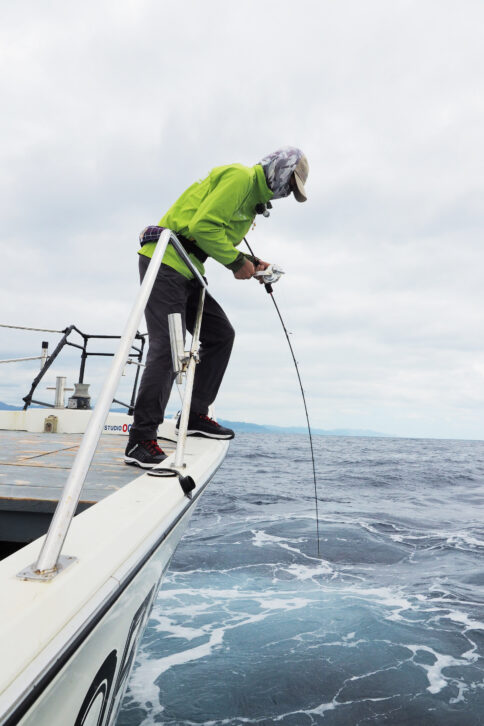
Stay calm, apply pressure with the drag while maintaining control. When you can reel, close the distance as much as possible.
Once the tuna finally nears the boat’s edge, it will circle. At this point, reel in the handle slightly as it approaches to close the distance. Even at this stage, anticipate another run or struggle, and carefully bring it closer. Once the tuna surfaces, it’s time for landing. Guide the leader to a spot where the deckhand can easily grab it. If releasing, inform the captain beforehand. Of course, prepare tools like the SOM Hook Remover HR550L-PRO for unhooking. Coordinate with the captain and fellow anglers on who handles the deck and who removes the hook for a smooth process.
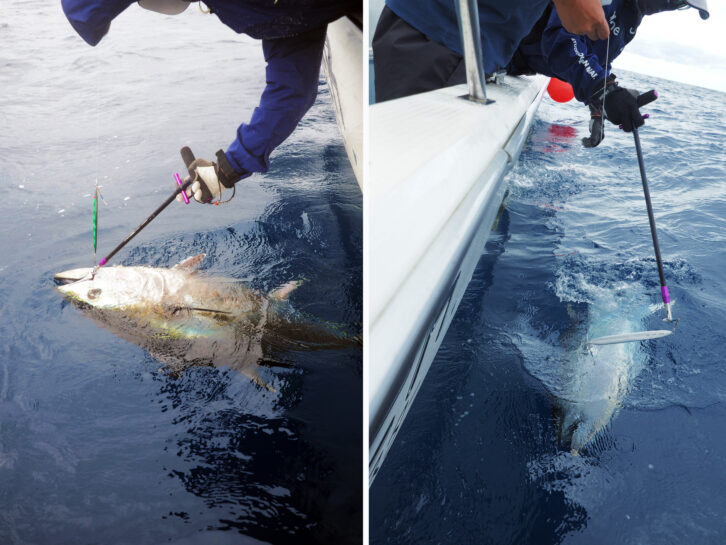
Teamwork is crucial in bluefin tuna fishing. Cooperation is needed for both landing and release.
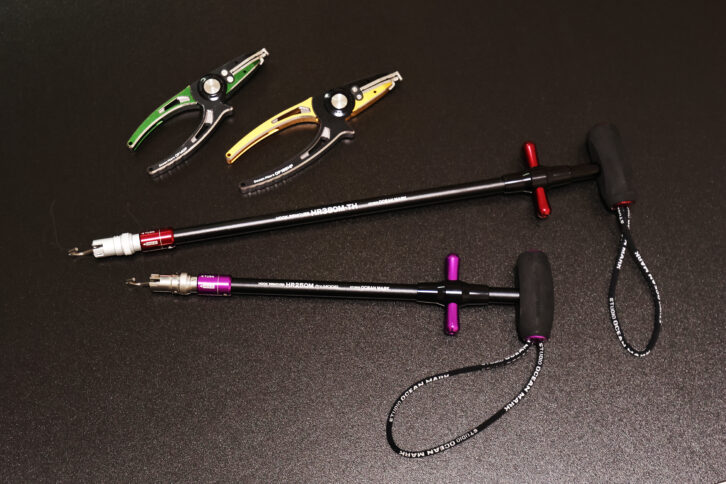
Release requires tools to remove hooks. SOM’s Hook Remover HR550L-PRO is a long model favored by many captains and anglers. Shorter models may suffice for boats with low gunwales. Additionally, bluefin tuna fishing uses heavy-duty rings, so pliers capable of opening them securely are essential. Pictured (top left) is the SOM Ocean Pliers OP165HP. It easily opens heavy-duty split rings.
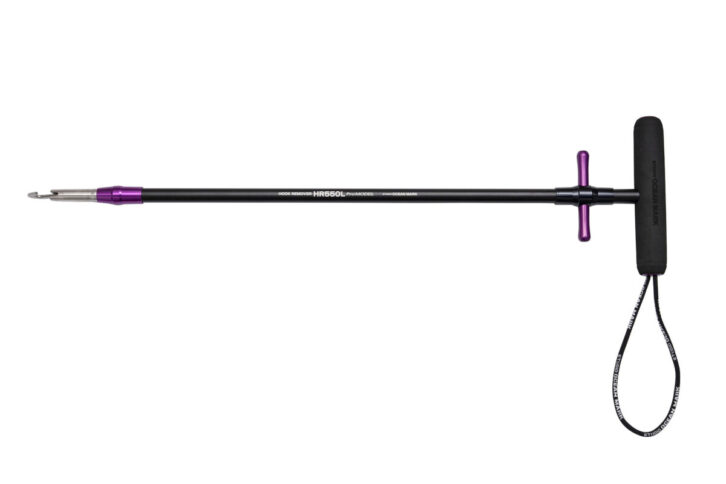
【SOM Hook Remover HR550L-PRO】
https://studio-oceanmark.com/products/hook-remover-promodel/
【SOM・Ocean Pliers OP165HP】
https://studio-oceanmark.com/products/ocean-pliers-op165hp-op140h/
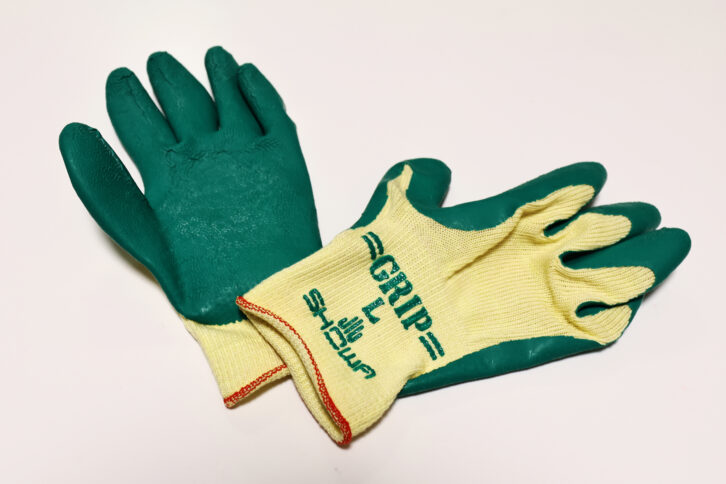
Prepare rubber gloves for releasing the fish. This allows you to grip the leader firmly and minimizes injury.
A word for anglers about to take on this challenge
Some anglers might see others on social media or nearby catching 100kg-class bluefin tuna and think, “I can probably do that too, just extending my usual jigging,” and decide to try. However, Mr. Nishimoto says these are extremely powerful targets, fights can last a long time, and it’s definitely not easy.
To successfully catch one, it’s best not to jump straight into targeting 100kg-class fish, but rather gradually increase the size and gain experience. However, in current bluefin tuna fishing, you might not always be able to choose the size. In that case, gaining experience first with yellowfin tuna around fish aggregating devices (FADs) or tuna jigging is also a good approach. Additionally, visualizing the fight and understanding the load during high drag is crucial. Bluefin tuna fishing carries the risk of injury from even minor mistakes, so tackling it with utmost caution and thorough preparation is vital.
“Fishing is best done solo, but if you genuinely feel it’s too difficult alone, I think it’s acceptable to take turns with your boatmates. Pushing yourself too hard and damaging your body or getting injured defeats the whole purpose. Also, since problems often occur during landing or release, I recommend using barbless hooks.”
The bluefin tuna migrating each year are growing larger in size. While Mr.Nishimoto has achieved results so far, he continues to evolve himself and is advancing further tackle development. In fact, during the interview, there were discussions about developments that cannot be disclosed here, making future developments something to look forward to.
